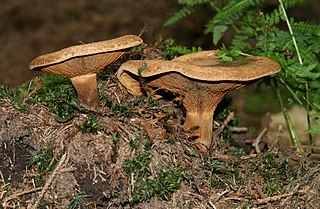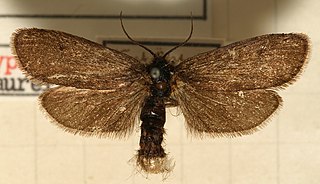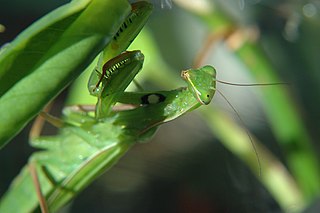Related Research Articles

The Cantharellaceae are a family of fungi in the order Cantharellales. The family contains the chanterelles and related species, a group of fungi that superficially resemble agarics but have smooth, wrinkled, or gill-like hymenophores. Species in the family are ectomycorrhizal, forming a mutually beneficial relationship with the roots of trees and other plants. Many of the Cantharellaceae, including the chanterelle, the Pacific golden chanterelle, the horn of plenty, and the trumpet chanterelle, are not only edible, but are collected and marketed internationally on a commercial scale.

Gelechioidea is the superfamily of moths that contains the case-bearers, twirler moths, and relatives, also simply called curved-horn moths or gelechioid moths. It is a large and poorly understood '"micromoth" superfamily, constituting one of the basal lineages of the Ditrysia.

Ancistrocladus is a genus of woody lianas in the monotypic family Ancistrocladaceae. The branches climb by twining other stems or by scrambling with hooked tips. They are found in the tropics of the Old World.

The Paxillaceae are a family of mushroom-forming fungi bearing close affinity to the boletes. Collectively, the family contains nine genera and 78 species. The type genus is Paxillus, containing fungi with decurrent gills, and Gyrodon, which has members with decurrent pores, among others. French mycologist René Maire had erected the family in 1902, placing it between the agarics and boletes and recognizing the groups' similarities with the latter group. Maire's usage of the name was later deemed to be invalid, and the genus authority is attributed to Johannes Paulus Lotsy. Molecular research confirms the relations of Gyrodon, with the decurrent-pored mushroom G. lividus, Paragyrodon, with the type species P. sphaerosporus, and Paxillus as sister groups, together lying near the base of a phylogenetic tree from which the genus Boletus arises. The name Gyrodontaceae, published by Belgian botanist Paul Heinemann in 1951, is considered synonymous with Paxillaceae.

The Batrachedridae are a small family of tiny moths. These are small, slender moths which rest with their wings wrapped tightly around their bodies.

Lypusidae is an obscure family of moths placed in the superfamily Gelechioidea.
The Congo shrews, members of the genus Congosorex, are mammals in the family Soricidae. The genus contains these species:
Thomandersia is the sole genus in the Thomandersiaceae, an African family of flowering plants. Thomandersia is a genus of shrubs and small trees, with six species native to Central and West Africa.

The genus Mantis is in the family Mantidae, of the mantis order Mantodea.

Egnasia is a genus of moths of the family Erebidae. The genus was first described by Francis Walker in 1859.

Depressaria is a genus of moths in the superfamily Gelechioidea. It is the type genus of subfamily Depressariinae, which is often – particularly in older treatments – considered a distinct family Depressariidae or included in the Elachistidae, but actually seems to belong in the Oecophoridae.
Maurice Philippe Gaspard Beeli was a Belgian mycologist.

Agonopterix is a moth genus of the superfamily Gelechioidea. It is placed in the family Depressariidae, which was often – particularly in older treatments – considered a subfamily of the Oecophoridae or included in the Elachistidae.
Brenania is a genus of flowering plants in the family Rubiaceae. It is found from Nigeria to Cameroon, Gabon, Cabinda, Central African Republic, Congo, and D.R.Congo. The genus was described in 1958 and contained only the type species Brenania spathulifolia.

Homotomidae is a family of small phloem-feeding bugs in the superfamily Psylloidea, or jumping plantlice.

Cantharellus luteopunctatus is a species of fungus in the genus Cantharellus. Found in Africa, it was described as new to science in 1928 by Belgian mycologist Maurice Beeli as Lentinus luteopunctatus. Paul Heinemann transferred it to Cantharellus in 1958.
Preussiodora is a genus of plants in the family Rubiaceae. It contains only one species, Preussiodora sulphurea, native to central Africa.

Anomologinae is a subfamily of moths in the family Gelechiidae.
The following lists events that happened during 1904 in the Congo Free State.